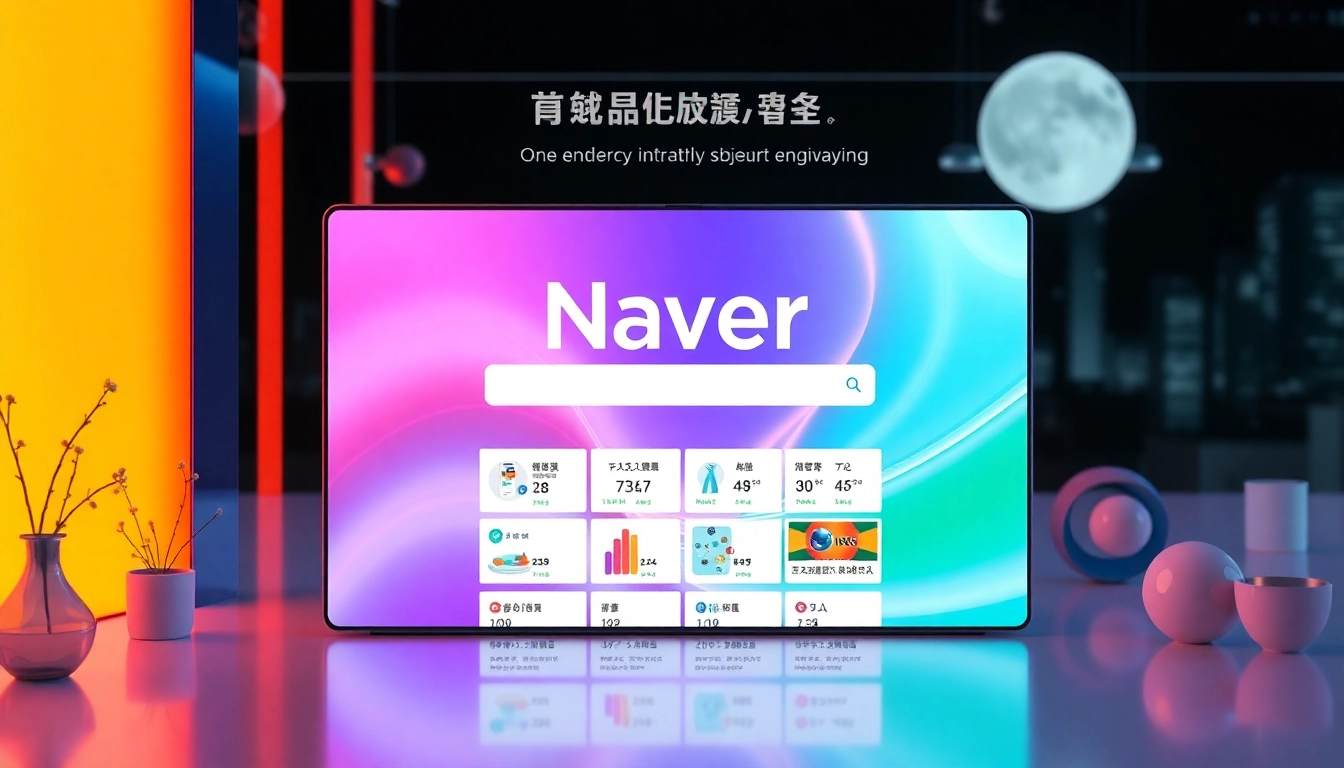
Introduction: The Significance of Naver in South Korea’s Digital Ecosystem
As South Korea’s most prominent online platform, naver stands as a technological cornerstone that shapes the digital experiences of millions. Launched in June 1999, Naver has evolved from a simple search engine to a comprehensive ecosystem integrating services like news, blogs, webtoons, shopping, and mobile payments, establishing itself as a dominant force in South Korea’s online landscape. Its extensive user base and innovative features have cemented its status as more than just a portal — it’s a vital part of daily life, influencing everything from internet browsing behaviors to e-commerce and digital communication. This article explores Naver’s extensive history, core offerings, strategic market dominance, optimization techniques, and future outlook, providing valuable insights for businesses, tech enthusiasts, and digital strategists aiming to leverage or understand this powerhouse.
Understanding Naver’s Origins and Core Offerings
Historical Background and Launch
Developed by Naver Corporation and officially launched on June 2, 1999, Naver emerged amidst the dot-com boom, positioning itself as South Korea’s premier online portal. Founded by Lee Hae-jin, the platform was designed to cater specifically to Korean users, addressing their unique language and cultural needs in the digital space. Unlike global giants like Google, Naver tailored its interface and services for local preferences, enabling rapid adoption and loyalty among Korean internet users. Over the years, the company diversified its product line, continuously innovating to stay ahead in a rapidly evolving digital market.
Core Products and Services
Naver’s ecosystem is multi-faceted, offering a bouquet of services that are tightly integrated to enhance user engagement. Its flagship product, the Naver search engine, is optimized for Korean language processing, featuring advanced algorithms that prioritize local content, news, and community-driven content like blogs and webtoons. Beyond search, Naver provides:
- Blogging and Webtoon Platforms: Encouraging content creation, fostering communities, and providing entertainment through popular webtoons.
- Maps and Navigation: Naver Map offers real-time traffic updates, detailed directions, and local business information tailored for Korean roads and infrastructure.
- Mobile Payments: Naver Pay integrates online payment solutions, facilitating seamless e-commerce transactions and mobile banking.
- News and Knowledge: Curated news feeds and a vast knowledge base support informed decision-making for users.
These offerings are further supported by email hosting, cloud services, and AI-powered tools, creating an all-encompassing digital environment for both consumers and businesses.
User Demographics and Market Penetration
Naver’s user demographic skews towards the broad spectrum of South Korean internet users, spanning from teenagers engaged in webtoons and social media to older adults relying on Naver for daily news and information. Its strategic localization, user-friendly interface, and culturally relevant content have contributed to a market share that exceeds 70% in web portal usage within South Korea. This dominance is reinforced through continuous innovation, mobile-first strategies, and tailored advertising solutions, securing Naver’s position as the go-to online platform for Koreans.
Naver’s Dominance in the South Korean Digital Landscape
Innovative Search Engine and Unique Features
Naver’s search engine outperforms global competitors within Korea by leveraging proprietary AI and natural language processing tailored to the Korean language. It features specialized search categories such as knowledge panels, local business listings, and multimedia-rich results that showcase news, images, and webtoons. Its “Knowledge iN” system fosters community-driven Q&A, making it a vital resource for localized content. Features like real-time trending searches and personalized recommendations enhance user engagement and retention.
Rich Content Ecosystem: Blogs, Webtoons, and News
Naver excels at creating a vibrant content ecosystem that sustains user interest. Webtoons, a uniquely Korean digital comic format, enjoys global popularity, supported by Naver’s webtoon platform, providing creators with monetization opportunities. Its news service aggregates content from various outlets, offering customized feeds aligned with user preferences. Blogging features foster community interaction and personal expression, strengthening user loyalty and time spent on the platform.
Mobile Integration and Payment Solutions
The transition to mobile dominance is complete in Korea, and Naver’s mobile app ecosystem offers streamlined access to all its services. Naver Pay facilitates quick, secure transactions, enabling businesses to integrate e-wallets directly into their websites and apps. Such seamless payment integration reduces friction, bolsters e-commerce sales, and provides detailed analytics for merchants aiming to optimize consumer outreach.
Strategies for Businesses to Maximize Naver’s Potential
Advertising: Targeted and Data-Driven
Naver’s advertising platform leverages its vast user data to facilitate hyper-targeted campaigns, similar to Google Ads but deeply integrated into the Korean context. Sponsored search results, banner ads, and native content marketing are tailored to specific demographics and interests. Success hinges on understanding Naver’s ad algorithms and creating culturally resonant content.
Data Analytics and API Utilization
Businesses can tap into Naver’s data analytics tools and APIs to gather insights on consumer behavior, optimize content strategies, and personalize user experiences. For example, Naver’s open APIs allow for integration with corporate systems, enabling real-time search, map, and commerce data to inform decision-making and personalization efforts.
Enterprises and New Entrants: Strategies for Success
New entrants should focus on localized content and partnerships with popular Naver services like webtoons or Naver Shopping. Building a presence via Naver’s platform requires understanding its ranking signals, content quality standards, and community engagement practices. Consistency, cultural relevance, and leveraging Naver’s advertising options are essential for differentiation and growth.
Optimizing Content and Strategies for Naver SEO
Understanding Naver’s Search Algorithm
Naver’s algorithm prioritizes local content, user engagement, and relevance. Unlike Google, it favors content that is current, community-driven, and multimedia-rich. Naver’s indexing favors blog posts, news articles, and webtoons, requiring content creators to optimize for these formats with proper tagging and keywords.
Content Optimization Tactics
- Keyword Relevance: Use Korean keywords naturally within titles, descriptions, and tags.
- Content Quality: Focus on original, informative, and engaging material to rank higher.
- Multimedia Usage: Incorporate images, videos, and webtoons to boost visibility and user engagement.
- Social Sharing and Community Engagement: Facilitate comment sections, shares, and interactions to boost content popularity.
Comparison with Global Search Engines
While Google emphasizes backlinks and keyword optimization, Naver’s ranking favors community content, localized relevance, and multimedia. Understanding these core differences is crucial for international businesses aiming to rank well on Naver, requiring tailored strategies distinct from Google SEO practices.
The Future of Naver and the Digital Frontier
Emerging Technologies and AI Integration
Naver heavily invests in AI and machine learning, embedding these into its search algorithms, chatbot services, and personalized recommendations. Its AI-powered Clova platform exemplifies efforts to enhance voice recognition, natural language understanding, and autonomous devices, positioning Naver at the forefront of Korea’s AI-driven digital revolution.
Expanding Globally and Market Opportunities
While primarily focused on Korea, Naver is exploring opportunities for international expansion through partnerships, language support, and localized versions of its key services. Its webtoon platform, for example, is gaining global traction, serving as a launchpad for broader international audiences.
Enhancing User Experience and Security
Future developments include strengthening data privacy, adding more intuitive interfaces, and integrating augmented reality (AR) and virtual reality (VR) features. These advancements aim to deepen user engagement, ensure security, and set new standards for seamless, safe digital experiences.






